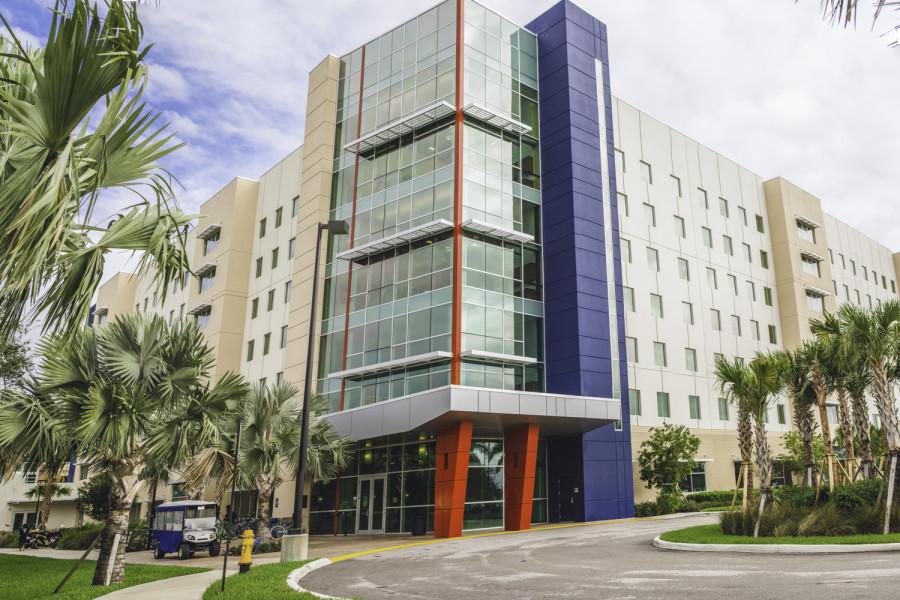Rooms for Improvement
On-campus occupancy rates are continuing to stagger. Students tell us what they want out of residence life.
 The shoe-box sized dorm room, dining hall food and annoying roommates are all thought to be part of the quintessential college experience, but that does not seem to be the situation at Florida Atlantic University.
The shoe-box sized dorm room, dining hall food and annoying roommates are all thought to be part of the quintessential college experience, but that does not seem to be the situation at Florida Atlantic University.
According to the Division of Student Affairs Department of Housing and Residential Life, since the 2012-2013 school year, occupancy rates have dropped from 91.8 percent to 86.6 percent.
As occupancy numbers have declined, FAU has attempted to make on-campus living more appealing to students.
Older residence halls like Algonquin Hall have been renovated while new luxury living spaces, including Parliament Hall that claims to offer ocean views, have been built. Also, the Recreation and Fitness Center opened in 2010 with the new football stadium following in 2011.
Yet, even with these new accommodations, the percentage of on-campus residents remains low.
According to FAU’s 2012-2013 annual report, only 15 percent of students lived on campus.To compare, the University of Florida had 24 percent of its students living on campus during the same school year, as stated in the school’s common data set statistics.
 At any university, resident life can be an ideal way to acclimate to campus, make friends and feel connected to the university — but it comes at a price. The high cost of living and strict rules often leave students craving the freedom that comes with moving off campus.
At any university, resident life can be an ideal way to acclimate to campus, make friends and feel connected to the university — but it comes at a price. The high cost of living and strict rules often leave students craving the freedom that comes with moving off campus.
“Living on campus is a great way to meet people as a freshman, but once you get past that initial awkwardness of making friends, you just want to be out on your own and not have to deal with all the rules,” said Alexis Perez, a junior neuroscience major who lived in Heritage Park Towers her freshman year before moving off campus.
Housing guidelines include regular room checks and restrictions on having certain items like candles, according to FAU’s Housing Guidebook.
Innovation Village Apartments, the newest upperclassmen residence hall, looks more like a swanky condo than a dorm room, but the luxury comes with a hefty price tag.
For the 2014-2015 school year, the least expensive room in IVA, a 4-bedroom apartment, costs $4,800 per student each semester. Freshman students living in Parliament Hall will pay $3,300 for a shared double dorm room.
“I’m not happy about the price. We were living in UVA last year, but we couldn’t get it this year because we signed up too late. [IVA]
is way more expensive. These upperclassman dorms tend to be pretty far away from everything … I’m sitting here walking half an hour to each class,” says Doug Stracher, a sophomore multimedia journalism major.
Now more than ever, FAU is facing stiffer competition from off-campus housing projects. Between University View, University Square and soon-to-be-built University Park, students have a variety of less expensive alternatives to the traditional residence halls within a mile of the school.
 “For me, living off campus was actually cheaper than living on campus,” says Brad Sarsony, a senior computer engineering major, “I spend about $100 less a month for more space and more privacy.”
“For me, living off campus was actually cheaper than living on campus,” says Brad Sarsony, a senior computer engineering major, “I spend about $100 less a month for more space and more privacy.”
One thing that these off-campus facilities can’t offer is convenience. Some students living in the residence halls either don’t have cars or can’t drive. Their classes, the dining hall, gym and the student union are only a short walk, longboard or bike ride away.
“Living off campus is really expensive to keep driving back and forth. All my classes are in the same spot and its way easier for me to just walk to class,” says Katurah Young, a sophomore English education major, living in IVA South for her second year.
For many students, the price of commuting pales in comparison to housing rates. Housing costs have steadily climbed throughout the years and will continue to be a deterrent for students as the university’s Board of Trustees approved another uptick in rates last November.
As for now, students on FAU Class of 2018 (Official) Facebook said that on-campus living would be more desirable if the school made a few alterations.
Currently students in the residence halls are required to purchase a meal plan. Optional meal plans could save students at least $1,512 if they choose to opt out. Residents also feel that room lockout charges are an unnecessary expense. Charges range from $15 to $25 each time they need assistance to get into their rooms.
Other students complained that the Wi-Fi connection is too slow and unreliable, which poses difficulty for those with online courses and programs. The housing department is already working on resolving this problem. They have just built a new Wi-Fi tower near the IVA residences and will add another to the UVA and Parliament side of campus in the next two to three weeks.
FAU is continuing to explore ways to improve resident life, especially for upper division students with more housing options.
“We have to find a way to show our returning students that there’s value to living on-campus and we’ve done that,” says Corey King, the interim vice president of Student Affairs. One thing we’ve done is free laundry, we’ve just updated our Wi-Fi. We’re looking to make things more convenient for students.”
Alexis is a marketing major with a computer science minor. She joined the University Press in the spring of 2014. Alexis has enjoyed experimenting with...
















